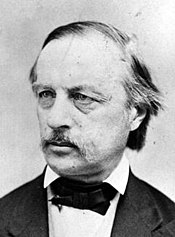|
Christian Heinrich Friedrich Peters
Christian Heinrich Friedrich Peters (September 19, 1813 – July 18, 1890) was a German–American astronomer and professor at Hamilton College, New York, and a pioneer in the study and visual discovery of asteroids. His name is often given as C. H. F. Peters.[1][2] BiographyHe was born in Koldenbüttel in Schleswig, then part of Denmark, but which was later annexed to Germany. His younger brother was the German explorer Wilhelm Peters.[3] He received a Ph.D from the University of Berlin in 1836 and thereafter continued his studies in Göttingen with the renowned mathematician Karl Friedrich Gauss. From 1838 to 1843 he was engaged in surveys of Mount Etna, in Sicily, where he also made astronomical observations, and afterwards participated in the complete geodetic survey of the island.[4] During the Revolutions of 1848, Peters became involved with some of the radical, antimonarchical groups in Sicily that brought him to the attention of authorities. He subsequently fled to France and eventually to the Ottoman Empire, where he became a government advisor.[5] At the suggestion of the resident U.S. consul in Istanbul, George P. Marsh, he emigrated to the United States in 1854. After an appointment as director of the new Dudley Observatory in Albany fell through, he made his way to Clinton, New York, where he was made director of the Litchfield Observatory at Hamilton College in 1858, and professor of astronomy in 1867. He was the first member of the Hamilton faculty to hold a Ph.D degree.[6] In 1874, Peters headed a United States Naval Observatory expedition to Queenstown, New Zealand, to observe the Transit of Venus. The visit is marked with a plaque, campaigned for by Sarah Salmond.[7] In 1878, Peters was elected as a member of the American Philosophical Society.[8] Working at Hamilton College's Litchfield Observatory in Clinton, New York (near Utica), he was a prolific discoverer of asteroids, discovering 48 of them, beginning with 72 Feronia in 1861 and ending with 287 Nephthys in 1889.[9] Besides asteroids, he co-discovered the periodic comet 80P/Peters–Hartley, and also discovered various nebulae and galaxies.[citation needed] Star Catalog ControversyBeginning in 1889, Peters was involved in litigation with his former student and assistant Charles A. Borst, in what became known as the "Great Star-Catalog Case".[10] While working for Peters as assistant director of the Litchfield Observatory, Borst had spent his spare time gathering an extensive amount of data for a new and revised star chart based on preliminary work done by Peters. When it came time to publish the results, however, Peters attempted to claim the entire project as his own, arguing that Borst was merely an employee and not a formal collaborator and that the research was his property as head of the observatory. Peters sued to force Borst to turn over the observational data he had collected.[11] The judge found for Peters, but many astronomers and newspapers sided with Borst and Peters died not long after. The initial judgment was ultimately reversed on appeal and a new trial was ordered, but it never took place. The eminent astronomer Simon Newcomb devotes a chapter in his memoirs to Peters, as an object lesson in how great scientific talent and poor ethical standards may coexist in a single individual.[12] He died July 18, 1890, in Utica. Historian William Sheehan notes, "Peters was found lying, a half-burned cigar at his fingertips, on the doorstep of the building where he lodged; observing cap on his head, he had fallen in the line of duty, on the way to the observatory the night before."[1] HonorsMain-belt asteroid 100007 Peters, discovered by Eric Walter Elst at La Silla Observatory in 1988, was named in his memory, based on a suggestion by French amateur astronomer Michel-Alain Combes (born 1942).[2] The asteroid measures approximately 7.5 kilometers in diameter and belongs to the carbonaceous Alauda family. The official naming citation was published by the Minor Planet Center on 5 January 2015 (M.P.C. 91792).[13] List of discovered minor planetsBetween 1861 and 1889, C. H. F. Peters discovered 48 asteroids at Litchfield Observatory (789) at Hamilton College, New York, where he enjoyed the title "Litchfield professor of astronomy".[1][9]
References
External links
|
||||||||||||||||||||||||||||||||||||||||||||||||||||||||||||||||||||||||||||||||||||||||||||||||||||||||||||||||||||||||||||||||||||||||||||||||||||||||||||||||||||||
